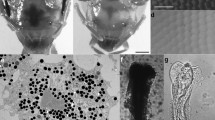Summary
The eye of Platynereis dumerilii consists of three components: a short optic nerve, a cup-shaped retina, and a vitreous body within the cup. The opening of the retinal cup is called pupil. The retina is composed of supporting cells and visual cells. The supporting cells are stuffed with dark blue violet pigment granules. The visual cells have orange pigment granules which are only found in the narrow middle piece of the cells. The supporting cell pigment may be lacking in abnormally pigmented eyes. The jellylike matter of the vitreous body apparently is produced by the supporting cells. It is of high protein contents and does not seem to be derived from the cuticle which consists of polysaccharides.
The ultrastructure of the photoreceptor region shows club-shaped processes of visual cells. Each club is of low electron density and contains elongate membranous structures. It is surrounded by many microvilli. The clubs correspond to the “rods” in light microscopy.
The eye of Platynereis dumerilii adapts to changes in light intensity by movements of the retina and the rods. The cup-shaped retina spreads towards its pupillar opening thus adapting the pupil area to light intensity. The length of the rods in darkfixed immature specimens is about 20μ, in light-fixed ones about 7 μ. In mature specimens (Heteronereis) the length is 46 μ or 19 μ respectively.
During metamorphosis the eyes enlarge to about three times their original volume. This enlargement is due to an increase in volume of the retina and the vitreous body, not to cell divisions.
Similar content being viewed by others
Literatur
Ameln, P.: Der Lichtsinn von Nereis diversicolor. Zool. Jb., Abt. allg. Zool. u. Physiol. 47 685–722 (1930).
Andrews, E. A.: On the eyes of polychaetous annelids. J. Morph. 7, 169–222 (1892).
Brökelmann, J., u. A. Fischer: Unveröffentlichte Befunde.
Buddenbrock, W. v.: Sinnesphysiologie. In: Vergleichende Physiologie, Bd. I. Basel: Birkhäuser 1952.
Burkhardt, D.: Die Eigenschaften und Funktionstypen der Sinnesorgane. Ergebn. Biol. 22, 226–267 (1960).
Eakin, R. M.: Line of evolution of photoreceptors. J. gen. Physiol. 46, 357A (1962).
Fernández-Morán, H.: The fine structure of vertebrate and invertebrate photoreceptors as revealed by low-temperature electron microscopy. In: G. K. Smelser (ed.), The structure of the eye. New York and London: Academic Press 1961.
Hansen, K.: Elektronenmikroskopische Untersuchung der Hirudineen-Augen. Zool. Beitr., N.F. 7, 83–128 (1962).
Hauenschild, C.: Photoperiodizität als Ursache des von der Mondphase abhängigen Metamorphose-Rhythmus bei dem Polychäten Platynereis dumerilii. Z. Naturforsch. 10b, 658–662 (1955).
—: Die Schwärmperiodizität von Platynereis dumerilii im DD/LD-Belichtungszyklus und nach Augenausschaltung. Z. Naturforsch. 16b, 753–756 (1961).
Herter, K.: Versuche über die Phototaxis von Nereis diversicolor. Z. vergl. Physiol. 4, 103–141 (1926).
Hess, C.: Die Akkommodation der Alciopiden, nebst Beiträgen zur Morphologie des Alciopidenauges. Pflügers Arch. ges. Phys. 172, 449–465 (1918).
Hesse, R.: Untersuchungen über die Organe der Lichtempfindung bei niederen Tieren. V. Die Augen polychäter Anneliden. Z. wiss. Zool. 65, 446–516 (1899).
Kaestner, A.: Lehrbuch der Speziellen Zoologie. Jena: Gustav Fischer 1954/55.
Kepner, W. A., and A. M. Foshee: Effects of light and darkness on the eye of Prorhynchus applanatus. J. exp. Zool. 23, 517–528 (1917).
Lüdtke, H.: Retinomotorik und Adaptationsvorgänge im Auge des Rückenschwimmers (Notonecta glauca L.). Z. vergl. Physiol. 35, 129–152 (1953).
Milne, L. J., and M. J. Milne: Invertebrate Photoreceptors. In: A. Hollaender (ed.), Radiation Biology, vol. III, p. 621–692. New York: McGraw-Hill Book Comp. Inc. 1956.
Parker, G. H.: The movements of the retinal pigment. Ergebn. Biol. 9, 239–291 (1932).
Pflugfelder, O.: Über den feineren Bau der Augen freilebender Polychäten. Z. wiss. Zool. 142, 540–586 (1932).
Portillo, J. de: Beziehungen zwischen den Öffnungswinkeln der Ommatidien, Krümmung und Gestalt der Insektenaugen und ihrer funktionellen Aufgaben. Z. vergl. Physiol. 23, 100–145 (1936).
Röhlich, P., u. L. J. Török: Elektronenmikroskopische Untersuchungen des Auges von Planarien. Z. Zellforsch. 54, 362–381 (1961).
—: The effects of light and darkness on the fine structure of the retinal clubs of Dendrocoelum lacteum. Quart. J. micr. Sci. 103, 543–548 (1962).
Schreiner, K. E.: Histologische Studien über die Augen der freilebenden marinen Borstenwürmer. Bergens Mus. Aarbog 1897, Nr. 8, 1–30.
Tampi, P. R. S.: On the eyes of polychaetes. Proc. Indian Acad. Sci. B 29, 129–147 (1949).
Vaupel-von Harnack, M.: Über den Feinbau des Nervensystems des Seesternes (Asterias rubens L.). III. Mitt. Die Struktur der Augenpolster. Z. Zellforsch. 60, 432–451 (1963).
Author information
Authors and Affiliations
Additional information
Durchgeführt mit Unterstützung durch ein Stipendium aus Mitteln der Fritz-Thyssen-Stiftung, ferner mit Hilfe der Deutschen Forschungsgemeinschaft.
Die Anregung zu dieser Arbeit und das Platynereis-Zuchtmaterial verdanke ich Herrn Prof. Dr. C. Hauenschild. Für Hilfe bei der Herstellung des Bildmaterials danke ich Frl. U. Poltz (Freiburg).
Rights and permissions
About this article
Cite this article
Fischer, A. Über den Bau und die Hell-Dunkel-Adaptation der Augen des Polychäten Platynereis dumerilii . Zeitschrift für Zellforschung 61, 338–353 (1963). https://doi.org/10.1007/BF00406996
Received:
Issue Date:
DOI: https://doi.org/10.1007/BF00406996




